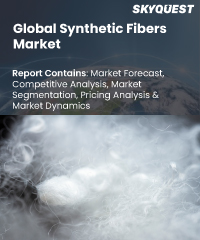
Report ID: SQMIG15A2163

Report ID:
SQMIG15A2163 |
Region:
Global |
Published Date: February, 2024
Pages:
157
|
Tables:
65 |
Figures:
75
The global synthetic fibers market is experiencing a rising adoption of advanced technologies and approaches, including the development of hybrid composites that combine synthetic and natural fibers. Market participants are actively seeking to enhance their sales by investing in partnerships and agreements with brand owners, e-commerce facilitators, and retailers, thereby contributing to the overall growth of the market. The market landscape is characterized by a fragmented nature, with numerous companies involved in product manufacturing. This fragmentation is attributed to the presence of extensive manufacturing and distribution facilities, catering to a large consumer base worldwide, which adds significant growth opportunities to the market.
Top Player’s Company Profiles
Recent Development
Our industry expert will work with you to provide you with customized data in a short amount of time.
REQUEST FREE CUSTOMIZATIONSynthetic Fibers Market size was valued at USD 61.70 billion in 2021 and is poised to grow from USD 66.2 billion in 2022 to USD 116.32 billion by 2030, growing at a CAGR of 7.3% during the forecast period (2023-2030).
The synthetic fibers market is experiencing a rising adoption of advanced technologies and approaches, including the development of hybrid composites that combine synthetic and natural fibers. Market participants are actively seeking to enhance their sales by investing in partnerships and agreements with brand owners, e-commerce facilitators, and retailers, thereby contributing to the overall growth of the market. The market landscape is characterized by a fragmented nature, with numerous companies involved in product manufacturing. This fragmentation is attributed to the presence of extensive manufacturing and distribution facilities, catering to a large consumer base worldwide, which adds significant growth opportunities to the market. 'Bombay Dyeing (India)', 'E. I. du Pont de Nemours and Company (US)', 'Indorama Corporation (Thailand)', 'Lenzing AG (Austria)', 'Mitsubishi Chemical Holdings Corporation (Japan)', 'Reliance Industries Limited (India)', 'China Petroleum Corporation (Sinopec Corp.) (China)', 'Teijin Limited (Japan)', 'Toray Chemical Korea, Inc. (South Korea)', 'Toyobo Co., Ltd. (Japan)', 'Asahi Kasei Corporation (Japan)', 'Invista (US)', 'Hyosung Corporation (South Korea)', 'Formosa Plastics Corporation (Taiwan)', 'Kolon Industries, Inc. (South Korea)', 'Far Eastern New Century Corporation (Taiwan)', 'Sinopec Yizheng Chemical Fibre Company Limited (China)', 'Nan Ya Plastics Corporation (Taiwan)', 'Huvis Corporation (South Korea)', 'Tongkun Group Co., Ltd. (China)'
One key market driver in the synthetic fibers market is the increasing demand from the textile industry. The textile industry is a major consumer of synthetic fibers, utilizing them in the production of clothing, home textiles, and technical textiles. The growing population, changing fashion trends, and rising disposable incomes are driving the demand for clothing, thereby fueling the demand for synthetic fibers.
One key market trend in the synthetic fibers market is the growing demand for sustainable and eco-friendly synthetic fibers. With increasing environmental consciousness and regulations promoting sustainable practices, there is a rising consumer preference for synthetic fibers that have minimal impact on the environment. Market players are responding to this trend by investing in research and development to create bio-based synthetic fibers and utilizing recycled materials in their manufacturing processes. This trend reflects the industry's commitment to addressing environmental concerns and meeting the evolving consumer demand for sustainable textile solutions.
Asia Pacific emerges as the leading region in the synthetic fibers market. The region's dominance can be attributed to several factors, including rapid industrialization, urbanization, and a burgeoning middle-class population. Countries such as China, India, and Bangladesh are major contributors to the growth of the synthetic fibers market in Asia Pacific. These countries have witnessed significant expansion in industries such as textiles, automotive, and construction, which are the major consumers of synthetic fibers. Additionally, the presence of a robust manufacturing base, favorable government policies, and increasing investments in infrastructure development further bolster the dominance of Asia Pacific in the synthetic fibers market.
Want to customize this report? This report can be personalized according to your needs. Our analysts and industry experts will work directly with you to understand your requirements and provide you with customized data in a short amount of time. We offer $1000 worth of FREE customization at the time of purchase.

Report ID: SQMIG15A2163